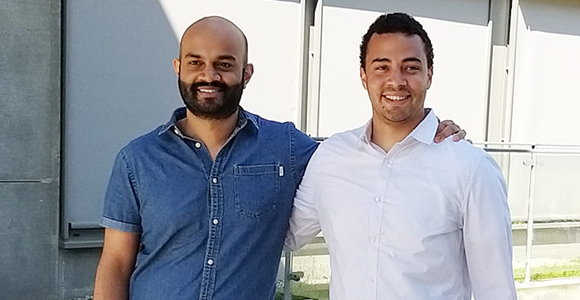
Thermographic cameras can detect critically ill patients
Two software engineering students from SDU have developed an app that uses thermal imaging to calculate the difference in temperature between a patient’s nose and corner of the eye. A consultant doctor in emergency medicine believes that thermal imaging could be the future when it comes to detecting critically ill patients.
Even for experienced emergency room physicians, assessing the medical state of a patient can be difficult. 31 % of the patients who are not deemed to be in an acute life-threatening condition develops a critical condition within 24 hours.
– We are hoping that our app will help the patients who suddenly enter a critical stage, says Karim Møller.
Karim Møller and Ruben Baskaran have developed a prototype for the app as part of their master’s thesis in Software Engineering at the University of Southern Denmark. The app uses thermal imaging to calculate the difference in temperature between a patient’s nose and corner of the eye.
”The nurse uses a smartphone to take a picture of the patient. The app then calculates the difference in temperature, which the doctor can use to assess the patient.
When our body is in a critical medical state, the circulation of blood centres around our vital organs. This causes the temperature on the surface of the body, such as the tip of the nose, to drop. In addition to this, studies show that the temperature in the corner of the eye is representative of our core temperature.
– A big difference between these two temperatures will indicate that the patient’s medical state could be worsening, explains Ruben Baskaran:
– Using artificial intelligence, the app automatically locates the corner of the eye and the tip of the nose, and it also automatically calculates the difference in temperature. The nurse uses a smartphone to take a picture of the patient. The app then calculates the difference in temperature, which the doctor can use to assess the patient.

Cold noses in Africa
Thermographic cameras are usually used when insulating a house or rescuing people. But to use thermal imaging of the body as a tool for doctors and nurses to assess patients is a completely new innovation.
– My colleagues probably think that I am a bit crazy, says Mikkel Brabrand, consultant doctor at the Hospital of South West Jutland and clinical professor in emergency medicine at the Department of Regional Health Research at SDU:
– It was actually a colleague working in Africa who gave me the idea. While in Africa, my colleague learned that a cold nose can be an indicator of a critically ill patient.
Large scale studies
Mikkel Brabrand is thrilled about the new app, because it allows him to perform large scale studies to test if thermal imaging can detect critically ill patients.
– We have conducted two smaller studies on 400 and 1000 patients. They show that the difference in temperature helps detect some of the patients that our current methods or an experienced doctor would not detect, says Mikkel Brabrand.
– But the studies are too small to draw conclusions. This app automates the process so I can now include thousands of patients in my research, says Mikkel Brabrand, who has not seen similar studies in Denmark or internationally.
Thermal imaging or thermometer
Ruben Baskaran and Karim Møller hope that their software will eventually help save patients’ lives.
– It makes a lot of sense to use thermal imaging to assess the body’s medical state. It is a bonus that the process does not require needles but only a picture, so it is very gentle on the patient, Ruben Baskaran says.
The two students also point to the fact that many airports are currently using thermographic cameras to detect passengers with a fever who might be carrying COVID-19.
– The technology has spread during the corona crisis. Who knows, maybe thermographic cameras will replace thermometers in the future, Karim Møller philosophizes.
Meet the researcher
Mikkel Brabrand is Professor in Emergency Medicine at Department of Regional Health Research at the University of Southern Denmark. He is the general manager of research groups in emergency medicine at the Hospital of South West Jutland in Esbjerg combined with clinical work at the emergency department at Odense University Hospital.